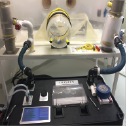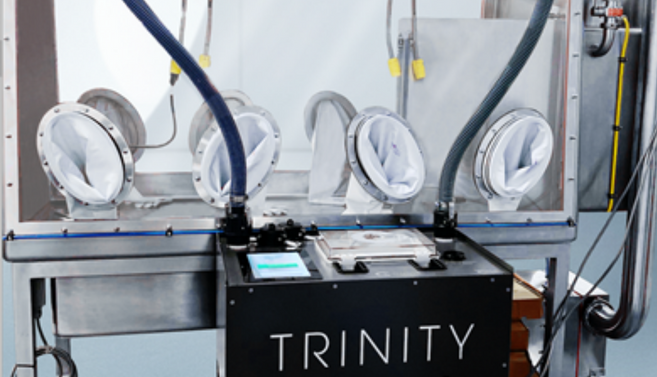5 Types of Isolators for Pharma and Life Science—The Best Ways to Decontaminate Them
In the world of GMP pharmaceutical manufacturing facilities, isolators enable sterile, contamination-free environments for sensitive processes such as manufacturing and research of GMP products and processes. They are also used to aid in safe handling of hazardous materials, toxins, and pathogens. Isolators are valuable because they provide the worker with a clean work environment that is relatively free of contamination from airborne particles. Extensive decontamination practices are employed routinely in these environments to help with contamination control.
Previously, vaporized hydrogen peroxide (VPHP) technology was employed to help maintain the biosafety of these environments. Today, less caustic forms of VPHP in the form of Hybrid Hydrogen Peroxide™ (HHP™) are frequently employed to ensure a validatable, repeatable 6-log process. This HHP™ technology includes the valuable qualities of vapor while also incorporating micro-aerosols to treat large and small enclosures more effectively without suffering from the effects of microclimates observed with legacy vapor-only systems. As seen in the recent revision of Annex I, there is a greater emphasis on the use of isolators and restricted access barriers (RABs) to help improve contamination control. CURIS’ HHP™ technology provides automated 6-log bioburden reduction cycles in these sensitive pieces of equipment and allows for a decreased cycle time compared to its legacy competitor, vapor phase hydrogen peroxide (VPHP).
Types of Isolators
Hazardous pathogens and chemicals remain a large part of the need for effective decontamination, as they can lead to the loss of valuable time, money, and research. To further understand the need for high-level decontamination, it is important to understand the types of isolators, how they are used, and how HHP™ systems can help with contamination control. They include:
-
Containment Isolators
These isolators are used specifically for handling hazardous materials or sensitive/potent pharmaceutical ingredients and infectious materials. Negative pressure systems are built into these isolators for an extra measure of protection and are generally employed in the pharmaceutical manufacturing industry. This is an ideal environment for HHP™ and VPHP systems that will inject and extract hydrogen peroxide while delivering a validatable 6-log cycle into these closed-loop isolators. HHP™ systems may provide faster cycle times, speed up decontamination, and provide safer material compatibility of the isolator materials. -
Aseptic Isolators
These isolators play a pivotal role in maintaining aseptic conditions when working with highly sensitive agents. Specialized HEPA filters are installed in the isolator to prevent the entry of contaminants. Aseptic isolators are used when formulating Total Parental Nutrition (TPN) and other sterile pharmacological mixtures. In the biotechnology industry, they are used when completing gene and cell therapy and tissue engineering. Sterility testing can also be completed using this equipment. VPHP and HHP™ systems will effectively treat the isolators and their equipment. HHP™ systems will also effectively treat the filtration system possibly eliminating potential contaminants in the filtration system as demonstrated in peer-reviewed studies. -
Flexible Film Isolators
Flexible f ilm isolators are routinely used to protect staff from infectious materials, pathogens, and blood. They are also used in the breading of germ-free mice for research. Their less expensive price tag has made them more popular in recent years and can be found in both positive and negative pressure designs. They are used in a variety of fields including pharmaceutical manufacturing, gnotobiotic, healthcare, and animal research. HHP™ systems have been extremely successful in treating these isolators’ filters, transfer ports, and their contents, without causing yellowing of film materials as seen with traditional VPHP systems using 35%-59% VPHP (Grinstead, Holland, Watkins 1). Additionally, HHP™ has been effective in shortening the time of comprehensive decontamination of these isolators from days to under an hour.
ilm isolators are routinely used to protect staff from infectious materials, pathogens, and blood. They are also used in the breading of germ-free mice for research. Their less expensive price tag has made them more popular in recent years and can be found in both positive and negative pressure designs. They are used in a variety of fields including pharmaceutical manufacturing, gnotobiotic, healthcare, and animal research. HHP™ systems have been extremely successful in treating these isolators’ filters, transfer ports, and their contents, without causing yellowing of film materials as seen with traditional VPHP systems using 35%-59% VPHP (Grinstead, Holland, Watkins 1). Additionally, HHP™ has been effective in shortening the time of comprehensive decontamination of these isolators from days to under an hour. -
Rigid Isolators
Rigid isolators are used when dealing with chemicals that are cytotoxic or have higher hazard risks. They are also used in the manufacturing and research of pathogens. They tend to be more expensive because they are made of stainless steel. Negative and positive pressure options are usually available for these isolators. The gaseous biocontamination alternatives include HHP™ and VPHP, both of which provide closed-system injection (Grinstead, et. al). Self-contained extraction of remaining decontaminant is ideal and HHP systems make this possible through extraction pod automation. HHP™ systems inject and extract hydrogen peroxide decontaminant.
usually available for these isolators. The gaseous biocontamination alternatives include HHP™ and VPHP, both of which provide closed-system injection (Grinstead, et. al). Self-contained extraction of remaining decontaminant is ideal and HHP systems make this possible through extraction pod automation. HHP™ systems inject and extract hydrogen peroxide decontaminant. -
Transfer Isolators
These isolators help prevent dangerous or sensitive materials from escaping during the transfer from one isolator to another by providing a barrier between the two. Traditional methods of biocontamination are peracetic acid or formaldehyde, both of which can take days to employ or clean up. HHP™ systems like TRINITY™ decrease treatment and turnaround time from 2 days to 2 hours with a 6-log repeatable result and no messy cleanup.
A Safer* System for Automated Isolator Biodecontamination
CURIS System devices provide a safer* and more efficacious treatment option for high-level disinfection of isolators, helping laboratories meet revised Annex 1 requirements (Table 1). HHP™ Technology capitalizes on vapor and submicron particles with a safer 7% H2O2 solution (compared to 35-59% currently employed), allowing for better material compatibility than its VPHP counterparts while still achieving repeatable and validatable sporicidal efficacy. No harmful or sticky residues are left behind as it breaks down into water and oxygen. The TRINITY™ system, ideal for isolator decontamination, is a mobile system capable of treating any isolator and producing a 6-log repeatable result validated with Geobacillus stearothermophilus biological indicators in Tyvek/Tyvek pouch. The TRINITY™ system automatically injects and extracts HH™P to comprehensively treat the isolator, filtration, and contents in as little as an hour. Risk management has also approved the use of TRINITY™ in facilities for isolator decontamination while the room is still in use due to its low potential for staff exposure.
Table 1.
How CURIS meets revised Annex 1 Isolator Biodecontamination Requirements (Section 4.22, i)
| Automated | √ |
| Validated 6-log repeatable results | √ |
| Controlled w/defined cycles | √ |
| Sporicidal gas/vapor | √ |
See the CURIS TRINITY™ in action:
Learn more about the CURIS System Product Line at www.curissystem.com
*than 35, 59% H2O2
Sources:
Grinstead F., Holland D., Watkins L. (Oct 2020). Effectiveness of Hybrid Hydrogen Peroxide in Decontamination of Closed-System Devices. CURIS Decontamination.
Cartwright E., Grinstead F., Mullens R., et al. (Oct. 2021). A Multi-Facility Examination of Novel Technology for Gnotobiotic Decontamination: Efficacy within Semi-Rigid and Soft-Sided Isolators. CURIS Decontamination.
Hislop M, Grinstead F, Henneman JR. Hybrid Hydrogen Peroxide for Viral Disinfection. In: Nims RW, Ijaz MK, editors. Disinfection of Viruses. 1st ed. London: IntechOpen; 2021. Available from: https://www.intechopen.com/chapters/79247 doi: 10.5772/intechopen.100237